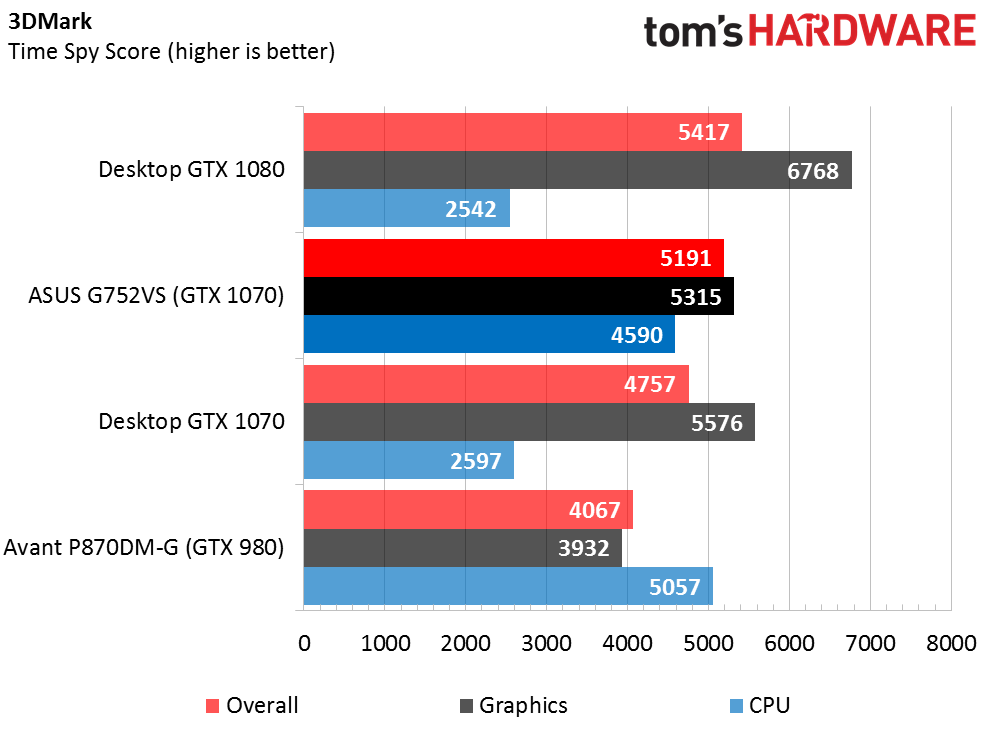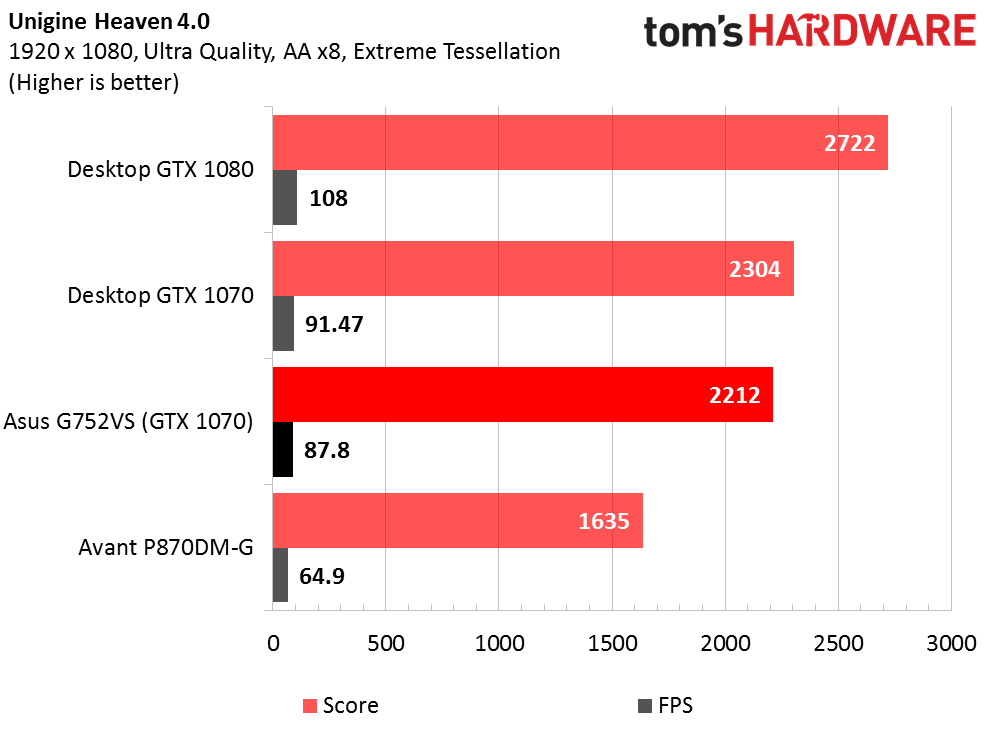First Benchmarks: Nvidia GeForce GTX 1070 Mobile Pascal
Gamers have wanted gaming laptops with desktop-class graphics for ages, and Nvidia made this a reality with the GeForce GTX 980 MXM. It seems that Nvidia’s mobile Pascal release has followed suit, and the “M” has been dropped altogether. The mobile Pascal cards are rumored to be just as powerful as their desktop counterparts, but let’s see if that’s truly the case.
For now, we’re able to confirm or deny at least one of Nvidia’s claims, and that is whether the mobile GTX 1070 is comparable to its desktop sibling. Our mobile GTX 1070 is the star of the G752VS gaming laptop, courtesy of Asus.
How We Test
To benchmark the mobile GTX 1070, we used two synthetic tests and one gaming test. 3DMark’s latest graphical benchmark, Time Spy, was used to measure the GTX 1070’s DX12 performance. We also used Unigine Heaven as our second synthetic test. Finally, Metro: Last Light Redux was used to measure actual gaming performance.
The competition this round is one of our test benches, running an Intel Core i7-6320 and 32GB of memory. The bench ran the tests with a desktop GTX 1070 and GTX 1080. For a third comparison, we added the AVADirect Avant P870D-MG, which has an Intel Core i7-6700K, 16GB of memory and a GeForce GTX 980 MXM.
Synthetic Benchmark - 3DMark Time Spy
Sure enough, the Asus G752VS’s mobile GTX 1070 scored similarly to the desktop GTX 1070. The test bench was running only an i3, which explains the lower CPU and overall scores, but the desktop GTX 1070 still outperformed the mobile card slightly during the graphics benchmark.
Synthetic Benchmark - Unigine Heaven
Once again, the mobile GTX 1070 performed quite similarly to its desktop counterpart. The Asus' average FPS was about four frames less than the GTX 1070-equipped desktop system, which translates to roughly 95% of the desktop's performance.
Get Tom's Hardware's best news and in-depth reviews, straight to your inbox.
Gaming Benchmark - Metro: Last Light Redux
Metro: Last Light Redux is known for being a particularly taxing benchmark, and until recently, even the most powerful single-card systems had trouble maxing it at highest settings at 1080p. Our Asus G752VS not only maintained a 60+ FPS average, it also just scraped by the desktop system. A better-equipped bench system would have handily beat the Asus laptop, however.
These are just a few preliminary benchmarks, but sure enough, Nvidia delivered on its promise. At the very least, the Nvidia GeForce GTX 1070 performed similarly to its desktop counterpart and outdid the GTX 980 MXM, previously the most powerful mobile graphics card. We witnessed slight performance differences favoring either the mobile or desktop GTX 1070 in different scenarios, but buyers can take comfort in knowing that Pascal-equipped laptops will have desktop-grade performance without many compromises. The deciding factor in the coming days will be determined by how fairly priced mobile Pascal systems will be.
-
bit_user Please use a more similar CPU, in the full benchmarks. Even if you have to underclock a desktop CPU.Reply
Also, I'm really looking forward to power, battery life, and noise measurements. How is battery life & performance, on battery? On AC power, does gaming or VR make the laptop sound like a hairdryer?
-
thor220 These aren't benchmarks, they're garbage. Comparing a 1070 in a desktop with an i3 of unnoted model to a laptop with a skylake i7.Reply
As a review site I no longer use Tom's because frankly it's obvious bottlenecks like this that show either obvious negligence and / or favoritism. It's on a higher level of stupidity than adding project cars to your benchmarking suite. -
Tron_knows Battery life? Really? Who plays games using the battery on a gaming laptop with highend graphic cards? Use the Intel graphics card if your worried the battery life.Reply -
nitrium Who in their right mind pairs an i3 with a GTX1070? How do these comparisons mean anything? No one here will learn anything useful from this test.Reply -
-Fran- You all missed the point of using the i3 it seems...Reply
To "simulate" the same CPU class of performance as in the notebook you have to cap the CPU power in the desktop side to make a more "apples to apples" comparison. Unless the notebook has a full fledged i5 or i7, a mobile Skylake is around the same as a desktop i3 or i5 at best.
I don't know why 3DMark punishes so much the core count in the CPU score, but you all can see in the aggregate it doesn't count that much (as it should be).
Cheers! -
hannibal I have phenom2 with 1070. More than double more speed than old 560ti... So i3 would be huge upgrade to me ;-)Reply -
Brian_R170 I'm more interested in a mini-PC with these GPUs. I imagine something the size of a Skull Canyon NUC that's maybe twice as thick to support the GPU, GDDR, and additional cooling.Reply


